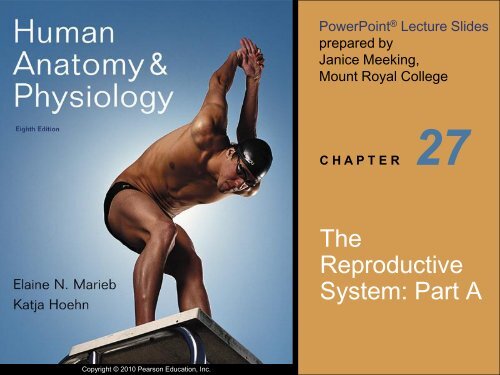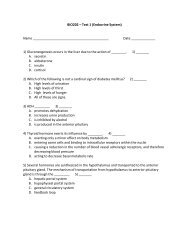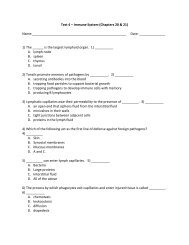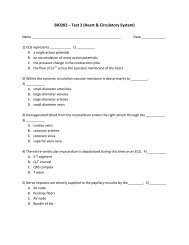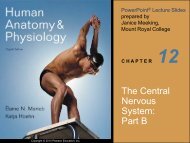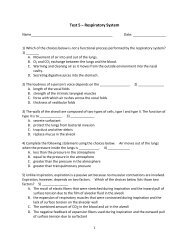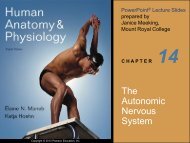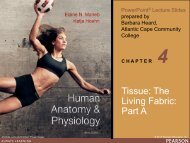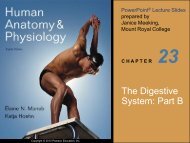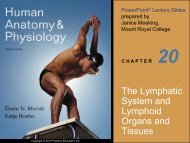The Reproductive System: Part A - Next2Eden
The Reproductive System: Part A - Next2Eden
The Reproductive System: Part A - Next2Eden
- No tags were found...
You also want an ePaper? Increase the reach of your titles
YUMPU automatically turns print PDFs into web optimized ePapers that Google loves.
PowerPoint ® Lecture Slidesprepared byJanice Meeking,Mount Royal CollegeC H A P T E R27<strong>The</strong><strong>Reproductive</strong><strong>System</strong>: <strong>Part</strong> ACopyright © 2010 Pearson Education, Inc.
<strong>Reproductive</strong> <strong>System</strong>• Primary sex organs (gonads): testes andovaries• Produce sex cells (gametes)• Secrete steroid sex hormones• Androgens (males)• Estrogens and progesterone (females)• Accessory reproductive organs: ducts, glands,and external genitaliaCopyright © 2010 Pearson Education, Inc.
<strong>Reproductive</strong> <strong>System</strong>• Sex hormones play roles in• Development and function of the reproductiveorgans• Sexual behavior and drives• Growth and development of many otherorgans and tissuesCopyright © 2010 Pearson Education, Inc.
Male <strong>Reproductive</strong> <strong>System</strong>• Testes (within the scrotum) produce sperm• Sperm are delivered to the exterior through asystem of ducts• Epididymis, ductus deferens, ejaculatory duct,and the urethraCopyright © 2010 Pearson Education, Inc.
PeritoneumSeminalvesicleAmpulla ofductusdeferensEjaculatoryductRectumProstateBulbourethralglandAnusBulb of penisDuctus (vas)deferensTestisScrotumUreterUrinary bladderProstaticurethraMembranousurethraUrogenitaldiaphragmPubisCorpuscavernosumCorpusspongiosumSpongy urethraEpididymisGlans penisPrepuceExternalurethral orificeCopyright © 2010 Pearson Education, Inc. Figure 27.1
<strong>The</strong> Scrotum• Sac of skin and superficial fascia• Hangs outside the abdominopelvic cavity• Contains paired testes• 3C lower than core body temperature(temperature necessary for spermproduction)Copyright © 2010 Pearson Education, Inc.
<strong>The</strong> Scrotum• Temperature is kept constant by two sets ofmuscles• Smooth muscle that wrinkles scrotal skin(dartos muscle)• Bands of skeletal muscle that elevate thetestes (cremaster muscles)Copyright © 2010 Pearson Education, Inc.
<strong>The</strong> Testes• Each is surrounded by two tunics• Tunica vaginalis, derived from peritoneum• Tunica albuginea, the fibrous capsule• Septa divide the testis into 250–300 lobules,each containing 1–4 seminiferous tubules(site of sperm production)Copyright © 2010 Pearson Education, Inc.
<strong>The</strong> Testes• Sperm are conveyed through• Seminiferous tubules• Tubulus rectus• Rete testis• Efferent ductules• EpididymisCopyright © 2010 Pearson Education, Inc.
<strong>The</strong> Testes• Blood supply comes from the testiculararteries and testicular veins• Spermatic cord encloses nerve fibers, bloodvessels, and lymphatics that supply the testesCopyright © 2010 Pearson Education, Inc.
Blood vesselsand nervesSpermatic cordDuctus (vas)deferensHead of epididymisEfferent ductuleRete testisStraight tubuleBody of epididymisDuct of epididymisTail of epididymis(a)TestisSeminiferoustubuleLobuleSeptumTunica albugineaTunica vaginalisCavity oftunica vaginalisCopyright © 2010 Pearson Education, Inc. Figure 27.3a
<strong>The</strong> Testes• Interstitial cells outside the seminiferoustubules produce androgens, specificallytestosteroneCopyright © 2010 Pearson Education, Inc.
Seminiferoustubule(c)Interstitial cellsAreolarconnectivetissueMyoidcellsSpermatogeniccells in tubuleepitheliumSpermCopyright © 2010 Pearson Education, Inc. Figure 27.3c
<strong>The</strong> Penis• Penis consists of• Root and shaft that ends in the glans penis• Foreskin—the cuff of loose skin covering theglans• Circumcision is the surgical removal of theforeskinCopyright © 2010 Pearson Education, Inc.
<strong>The</strong> Penis• External anatomy includes section of urethracalled spongy urethra and three cylindricalbodies of erectile tissue (spongy network ofconnective tissue and smooth muscle withvascular spaces)• Corpus spongiosum surrounds the urethra andexpands to form the glans• Corpora cavernosa are paired dorsal erectilebodies• Erection: erectile tissue fills with blood,causing the penis to enlarge and become rigidCopyright © 2010 Pearson Education, Inc.
UreterAmpulla of ductus deferensUrinary bladderProstateProstatic urethraOrifices of prostatic ductsMembranous urethraRoot of penisShaft (body) of penis(a)Seminal vesicleEjaculatory ductBulbourethral gland and ductUrogenital diaphragmBulb of penisCrus of penisBulbourethral duct openingDuctus deferensCorpora cavernosaEpididymisCorpus spongiosumTestisSection of (b)Spongy urethraGlans penisPrepuce (foreskin)External urethral orificeDorsal vesselsand nervesSkinDeep arteries(b)Corpora cavernosaUrethraTunica albuginea of erectile bodiesCorpus spongiosumCopyright © 2010 Pearson Education, Inc. Figure 27.4
<strong>The</strong> Male Duct <strong>System</strong>• Epididymis• Ductus deferens• Ejaculatory duct• UrethraCopyright © 2010 Pearson Education, Inc.
Epididymis• Head: contains the efferent ductules• Duct of the epididymis• Microvilli (stereocilia) absorb testicular fluidand pass nutrients to stored sperm• Nonmotile sperm enter, pass slowly through,and become motile• During ejaculation the epididymis contracts,expelling sperm into the ductus deferensCopyright © 2010 Pearson Education, Inc.
Blood vesselsand nervesSpermatic cordDuctus (vas)deferensHead of epididymisEfferent ductuleRete testisStraight tubuleBody of epididymisDuct of epididymisTail of epididymis(a)TestisSeminiferoustubuleLobuleSeptumTunica albugineaTunica vaginalisCavity oftunica vaginalisCopyright © 2010 Pearson Education, Inc. Figure 27.3a
Ductus Deferens and Ejaculatory Duct• Ductus deferens• Passes through the inguinal canal• Expands to form the ampulla and then joinsthe duct of the seminal vesicle to form theejaculatory duct• Propels sperm from the epididymis to theurethra• Vasectomy: cutting and ligating the ductusdeferens, which is a nearly 100% effectiveform of birth controlCopyright © 2010 Pearson Education, Inc.
UreterAmpulla of ductus deferensUrinary bladderProstateProstatic urethraOrifices of prostatic ductsMembranous urethraRoot of penisShaft (body) of penis(a)Seminal vesicleEjaculatory ductBulbourethral gland and ductUrogenital diaphragmBulb of penisCrus of penisBulbourethral duct openingDuctus deferensCorpora cavernosaEpididymisCorpus spongiosumTestisSection of (b)Spongy urethraGlans penisPrepuce (foreskin)External urethral orificeDorsal vesselsand nervesSkinDeep arteries(b)Corpora cavernosaUrethraTunica albuginea of erectile bodiesCorpus spongiosumCopyright © 2010 Pearson Education, Inc. Figure 27.4
Accessory Glands: Seminal Vesicles• Produces viscous alkaline seminal fluid• Fructose, ascorbic acid, coagulating enzyme(vesiculase), and prostaglandins• 70% of the volume of semen• Duct of seminal vesicle joins the ductusdeferens to form the ejaculatory ductCopyright © 2010 Pearson Education, Inc.
Accessory Glands: Prostate• Encircles part of the urethra inferior to thebladder• Secretes milky, slightly acid fluid:• Contains citrate, enzymes, and prostatespecificantigen (PSA)• Plays a role in the activation of sperm• Enters the prostatic urethra during ejaculationCopyright © 2010 Pearson Education, Inc.
Accessory Glands: Bulbourethral Glands• Pea-sized glands inferior to the prostate• Prior to ejaculation, produce thick, clearmucus• Lubricates the glans penis• Neutralizes traces of acidic urine in the urethraCopyright © 2010 Pearson Education, Inc.
UreterAmpulla of ductus deferensUrinary bladderProstateProstatic urethraOrifices of prostatic ductsMembranous urethraRoot of penisShaft (body) of penis(a)Seminal vesicleEjaculatory ductBulbourethral gland and ductUrogenital diaphragmBulb of penisCrus of penisBulbourethral duct openingDuctus deferensCorpora cavernosaEpididymisCorpus spongiosumTestisSection of (b)Spongy urethraGlans penisPrepuce (foreskin)External urethral orificeDorsal vesselsand nervesSkinDeep arteries(b)Corpora cavernosaUrethraTunica albuginea of erectile bodiesCorpus spongiosumCopyright © 2010 Pearson Education, Inc. Figure 27.4
Semen• Mixture of sperm and accessory glandsecretions• Contains nutrients (fructose), protects andactivates sperm, and facilitates theirmovement (e.g., relaxin)• Prostaglandins in semen• Decrease the viscosity of mucus in the cervix• Stimulate reverse peristalsis in the uterusCopyright © 2010 Pearson Education, Inc.
Semen• Alkalinity neutralizes the acid in the maleurethra and female vagina• Antibiotic chemicals destroy certain bacteria• Clotting factors coagulate semen just afterejaculation, then fibrinolysin liquefies it• Only 2–5 ml of semen are ejaculated,containing 20–150 million sperm/mlCopyright © 2010 Pearson Education, Inc.
Male Sexual Response• Erection• Enlargement and stiffening of the penis fromengorgement of erectile tissue with blood• Initiated by sexual stimuli, including:• Touch and mechanical stimulation of thepenis• Erotic sights, sounds, and smells• Can be induced or inhibited by emotions orhigher mental activityCopyright © 2010 Pearson Education, Inc.
Male Sexual Response• Erection:• Parasympathetic reflex promotes release ofnitric oxide (NO)• NO causes erectile tissue to fill with blood• Expansion of the corpora cavernosa• Compresses drainage veins and maintainsengorgement• Corpus spongiosum keeps the urethra open• Impotence: the inability to attain erectionCopyright © 2010 Pearson Education, Inc.
Male Sexual Response• Ejaculation• Propulsion of semen from the male ductsystem• Sympathetic spinal reflex causesCopyright © 2010 Pearson Education, Inc.• Ducts and accessory glands to contract andempty their contents• Bladder sphincter muscle to constrict,preventing the expulsion of urine• Muscles in shaft undergo a rapid series ofcontractions leading to climax and thenresolution
Copyright © 2010 Pearson Education, Inc.
Spermatogenesis• Sequence of events that produces sperm inthe seminiferous tubules of the testes• Most body cells are diploid (2n) and contain• Two sets of chromosomes (one maternal, onepaternal)• 23 pairs of homologous chromosomes• Gametes are haploid (n) and contain• 23 chromosomesCopyright © 2010 Pearson Education, Inc.
Meiosis• Gamete formation involves meiosis• Nuclear division in the gonads in which thenumber of chromosomes is halved (from 2nto n)• Two consecutive cell divisions (meiosis Iand II) following one round of DNA replication• Produces four daughter cells• Introduces genetic variationCopyright © 2010 Pearson Education, Inc.
CentriolepairsInterphase cell2n = 4NuclearenvelopeChromatinInterphase eventsAs in mitosis, meiosis is precededby DNA replication and otherpreparations for cell division.MEIOSIS ICrossoverSpindleSisterchromatidsNuclear envelopefragments latein prophase ICentromereProphase IProphase events occur, as in mitosis. Additionally,synapsis occurs: Homologous chromosomes cometogether along their length to form tetrads. Duringsynapsis, the “arms” of homologous chromatids wraparound each other, forming several crossovers. <strong>The</strong>nonsister chromatids trade segments at points ofcrossover. Crossover is followed through the diagramsbelow.Metaphase I<strong>The</strong> tetrads align randomly on the spindleequator in preparation for anaphase.TetradDyadChromosomesuncoilNuclearenvelopesre-formCleavagefurrowAnaphase IUnlike anaphase of mitosis, the centromeres do notseparate during anaphase I of meiosis, so the sisterchromatids (dyads) remain firmly attached. However, thehomologous chromosomes do separate from each otherand the dyads move toward opposite poles of the cell.Telophase I<strong>The</strong> nuclear membranes re-form around thechromosomal masses, the spindle breaks down, andthe chromatin reappears as telophase and cytokinesisare completed. <strong>The</strong> 2 daughter cells (now haploid)enter a second interphase-like period, calledinterkinesis, before meiosis II occurs. <strong>The</strong>re is nosecond replication of DNA before meiosis II.Copyright © 2010 Pearson Education, Inc. Figure 27.6 (1 of 2)
MEIOSIS IIProphase IIMetaphase IIMeiosis II begins with theproducts of meiosis I (2haploid daughter cells) andundergoes a mitosis-likenuclear division processreferred to as the equationaldivision of meiosis.Anaphase IITelophase IIand cytokinesisProducts ofmeiosis:haploiddaughter cellsAfter progressing through thephases of meiosis andcytokinesis, the product is 4haploid cells, each geneticallydifferent from the originalmother cell. (During humanspermatogenesis, the daughtercells remain interconnected bycytoplasmic extensions duringthe meiotic phases.)Copyright © 2010 Pearson Education, Inc. Figure 27.6 (2 of 2)
Mother cell(before chromosome replication)MITOSISChromosomereplication2n = 4ChromosomereplicationMEIOSISProphaseReplicatedchromosomeProphase ITetrad formed bysynapsis of replicatedhomologouschromosomesMetaphaseDaughtercells ofmitosisChromosomesalign at themetaphase plateSister chromatidsseparate duringanaphaseMetaphase IHomologous chromosomesseparate but sisterchromatids remain togetherduring anaphase IDaughter cellsof meiosis ITetrads align at themetaphase plate2n2nMeiosis IINo further chromosomalreplication; sister chromatidsseparate duringanaphase IIn n nDaughter cells of meiosis IIn(usually gametes)Copyright © 2010 Pearson Education, Inc. Figure 27.5 (1 of 2)
Number ofdivisionsSynapsis ofhomologouschromosomesDaughter cellnumber andgeneticcompositionRoles in the bodyMITOSISOne, consisting of prophase, metaphase,anaphase, and telophase.Does not occur.Two. Each diploid (2n) cell is identical tothe mother cell.For development of multicellular adultfrom zygote. Produces cells for growthand tissue repair. Ensures constancy ofgenetic makeup of all body cells.MEIOSISTwo, each consisting of prophase, metaphase,anaphase, and telophase. DNA replication doesnot occur between the two nuclear divisions.Occurs during mitosis I; tetrads formed,allowing crossovers.Four. Each haploid (n) cell contains half as manychromosomes as the mother cell and isgenetically different from the mother cell.Produces cells for reproduction (gametes).Introduces genetic variability in the gametes andreduces chromosomal number by half so that whenfertilization occurs, the normal diploid chromosomalnumber is restored (in humans, 2n = 46).Copyright © 2010 Pearson Education, Inc. Figure 27.5 (2 of 2)
Spermatogenesis• Spermatic cells give rise to sperm• Mitosis• Spermatogonia form spermatocytes• Meiosis• Spermatocytes form spermatids• Spermiogenesis• Spermatids become spermCopyright © 2010 Pearson Education, Inc.
Copyright © 2010 Pearson Education, Inc. Figure 27.7a
Basal laminaSpermatogonium(stem cell)Type A daughter cellremains at basal laminaas a stem cellType B daughter cellTight junction betweensustentacular cellsPrimaryspermatocyteSecondaryspermatocytesEarlyspermatidsLate spermatidsCytoplasm of adjacentsustentacular cellsSustentacularcell nucleusSpermatozoaCytoplasmicbridgeLumen ofseminiferoustubule(c) A portion of the seminiferous tublule wall, showing the spermatogeniccells surrounded by sustentacular cells (colored gold)Copyright © 2010 Pearson Education, Inc. Figure 27.7c
Mitosis of Spermatogonia• Begins at puberty• Spermatogonia• Stem cells in contact with the epithelial basallamina• Each mitotic division a type A daughter celland a type B daughter cellCopyright © 2010 Pearson Education, Inc.
Mitosis of Spermatogonia• Type A cells maintain the germ cell line at thebasal lamina• Type B cells move toward the lumen anddevelop into primary spermatocytesCopyright © 2010 Pearson Education, Inc.
Meiosis: Spermatocytes to Spermatids• Meiosis I• Primary spermatocyte (2n) two secondaryspermatocytes (n)• Meiosis II• Each secondary spermatocyte (n) twospermatids (n)• Spermatid: small nonmotile cells close to thelumen of the tubuleCopyright © 2010 Pearson Education, Inc.
Spermatogonium(stem cell)MitosisGrowthEnters meiosis Iand moves toadluminalcompartmentMeiosis IcompletedMeiosis IIBasal laminaType A daughter cellremains at basal laminaas a stem cellType B daughter cellPrimaryspermatocyteSecondaryspermatocytesEarlyspermatidsLate spermatidsSpermatozoa(b) Events of spermatogenesis,showing the relative positionof various spermatogenic cellsCopyright © 2010 Pearson Education, Inc. Figure 27.7b
Spermiogenesis: Spermatids to Sperm• Spermatids lose excess cytoplasm and form atail, becoming spermatozoa (sperm)Copyright © 2010 Pearson Education, Inc.
Sperm• Major regions1. Head: genetic region; nucleus and helmetlikeacrosome containing hydrolytic enzymes thatenable the sperm to penetrate an egg2. Midpiece: metabolic region; mitochondria3. Tail: locomotor region; flagellumCopyright © 2010 Pearson Education, Inc.
Approximately 24 daysGolgiapparatusAcrosomalvesicleMitochondriaAcrosomeNucleus1 2(a)SpermatidnucleusCentrioles3MicrotubulesFlagellumExcesscytoplasmMidpiece Head45Tail6 7(b)Copyright © 2010 Pearson Education, Inc.Figure 27.8a, b
Role of Sustentacular Cells• Large supporting cells (Sertoli cells)• Extend through the wall of the tubule andsurround developing cells• Provide nutrients and signals to dividing cells• Dispose of excess cytoplasm sloughed offduring spermiogenesis• Secrete testicular fluid into lumen for transportof spermCopyright © 2010 Pearson Education, Inc.
Role of Sustentacular Cells• Tight junctions divide the wall into twocompartments1. Basal compartment—spermatogonia andprimary spermatocytes2. Adluminal compartment—meiotically activecells and the tubule lumenCopyright © 2010 Pearson Education, Inc.
Basal laminaSpermatogonium(stem cell)Type A daughter cellremains at basal laminaas a stem cellType B daughter cellTight junction betweensustentacular cellsPrimaryspermatocyteSecondaryspermatocytesEarlyspermatidsLate spermatidsCytoplasm of adjacentsustentacular cellsSustentacularcell nucleusSpermatozoaCytoplasmicbridgeLumen ofseminiferoustubule(c) A portion of the seminiferous tublule wall, showing the spermatogeniccells surrounded by sustentacular cells (colored gold)Copyright © 2010 Pearson Education, Inc. Figure 27.7c
Role of Sustentacular Cells• Tight junctions form a blood-testis barrier• Prevents sperm antigens from escaping intothe blood where they would activate theimmune system• Because sperm are not formed until puberty,they are absent during immune systemdevelopment, and would not be recognized as“self”Copyright © 2010 Pearson Education, Inc.
Hormonal Regulation of Male <strong>Reproductive</strong>Function• A sequence of hormonal regulatory eventsinvolving the hypothalamus, anterior pituitarygland, and the testes• <strong>The</strong> hypothalamic-pituitary-gonadal (HPG) axisCopyright © 2010 Pearson Education, Inc.
HPG Axis1. Hypothalamus releases gonadotropinreleasinghormone (GnRH)2. GnRH stimulates the anterior pituitary tosecrete FSH and LH3. FSH causes sustentacular cells to releaseandrogen-binding protein (ABP), whichmakes spermatogenic cell receptive totestosterone4. LH stimulates interstitial cells to releasetestosteroneCopyright © 2010 Pearson Education, Inc.
HPG Axis5. Testosterone is the final trigger forspermatogenesis6. Feedback inhibition on the hypothalamusand pituitary results from• Rising levels of testosterone• Inhibin (released when sperm count is high)Copyright © 2010 Pearson Education, Inc.
1Anteriorpituitary82GnRHVia portalblood7InhibinFSH23 4LHInterstitialcellsTestosteroneSustentacularcellSpermatogeniccells56Somatic andpsychologicaleffects atother bodysitesSeminiferoustubuleStimulatesInhibitsCopyright © 2010 Pearson Education, Inc. Figure 27.9
Mechanism and Effects of TestosteroneActivity• Testosterone• Synthesized from cholesterol• Transformed to exert its effects on some targetcells• Dihydrotestosterone (DHT) in the prostate• Estrogen in some neurons in the brainCopyright © 2010 Pearson Education, Inc.
Mechanism and Effects of TestosteroneActivity• Prompts spermatogenesis• Targets all accessory organs; deficiency leadsto atrophy• Has multiple anabolic effects throughout thebody• Is the basis of the sex drive (libido) in malesCopyright © 2010 Pearson Education, Inc.
Male Secondary Sex Characteristics• Features induced in the nonreproductiveorgans by male sex hormones (mainlytestosterone)• Appearance of pubic, axillary, and facial hair• Enhanced growth of the chest and deepeningof the voice• Skin thickens and becomes oily• Bones grow and increase in density• Skeletal muscles increase in size and massCopyright © 2010 Pearson Education, Inc.


